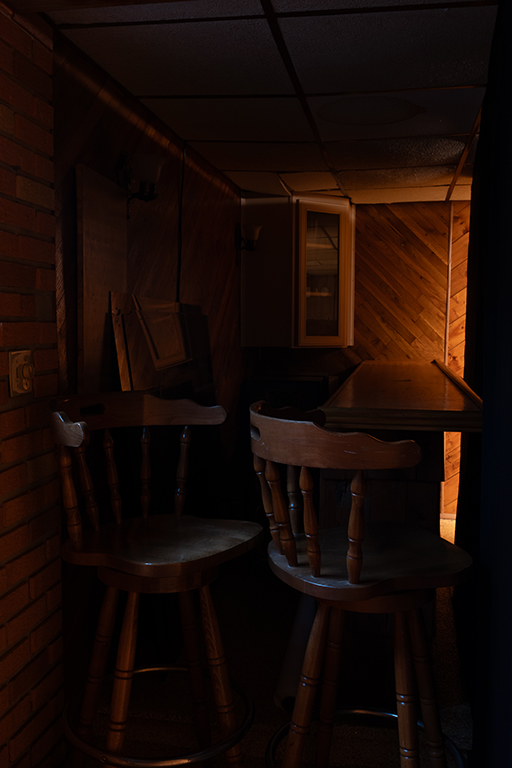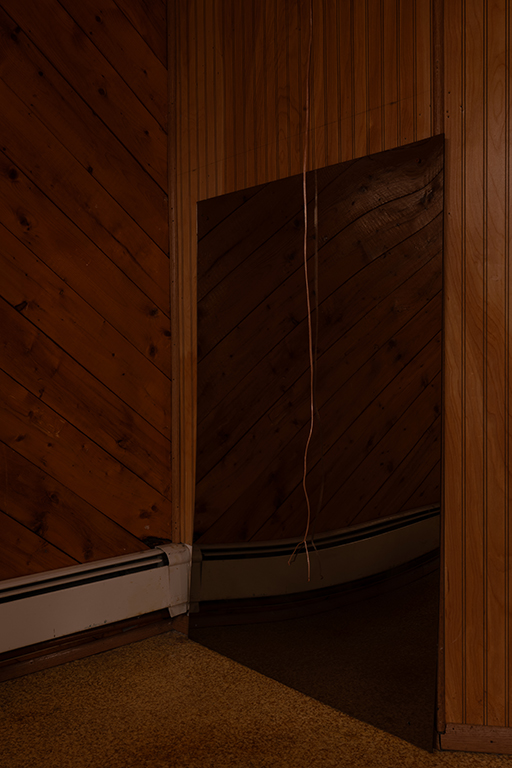Own Your Own
Bradley Kronz at Gaylord Apartments, Los Angeles, and Gandt, New York
Bradley Kronz at Gaylord Apartments, Los Angeles, and Gandt, New York
by Anna-Sophie Berger
The writer of this review is weary of the proliferation of diaristic, subjective first-person accounts in art writing. She has declared it a rule for now not to write directly about herself and her personal experience. She is therefore reluctant to disclose her relationship to the artist and venues in question even though she appreciates the concept of the disclaimer as a means to unhide nepotistic relations or else to confess kinship in art criticism.


American artist Bradley Kronz opened two exhibitions consecutively in the winter of 2024. One in late February at the Gaylord Apartments, Los Angeles, to a tacit spring, the second a month later to the day, at Gandt in ice cold Astoria, New York. This move – if one assumes this temporal squeeze or protracted tour de force to be part of the artist’s intention – made for a particularly strange if candid form of institutional critique cum artistic self-reference.
To start on the West Coast: the Gaylord Apartment building was constructed in the early ‘20s on Wilshire Boulevard in Renaissance Revival style and was once one of the city’s first fully furnished co-op buildings, if only to be dissolved in the ‘30s. From the original signboard advertising the apartments: “Starting Thursday Feb. 21 all apartments in the magnificent Gaylord, completely furnished, will be sold as ‘Own Your Own Apartment’”. As a latter-day high-rise, it has the charm of a slowly decaying, full board hotel with lobby et al. The eponymous gallery is artist-run from an apartment on the 14th floor. The 180-degree view across the sprawling metropolis is astonishing even in a city of hillside vistas and the windows that puncture the walls of the main exhibition space are the backdrop to any art shown here.
Kronz opted for eight discrete sculptures, noticeably forgoing their installational integration within the Gaylord environment. If anything, the objects all clearly betrayed their common provenance in a place not quite here. Designer of the Cross and Fake spirituality filled with darkness (both 2024) are dark stained wood pieces mounted on the wall that, on sidelong inspection, reveal inner contents wedged by more wood. In the former, conduits and cables are wrapped around the inside of the wood-and-drywall wedge along with more verily detritus, such as dry leaves and paper: The wood board a giant spool, the gesture of wrapping a formal as much as a practical one. In the latter, it is wool that is being used as stuffing (or insulation?) nudging us ever closer towards thinking of these objects as panels with additional purpose (soundproofing?). However, the wool appears strangely human-cherub-lock-like and therefore eerie enough to set off any pretension to practical home construction. In these gestures, the unresolved relationship between decoration and utility is at its most striking.
Moving on to Lives in NY, Works in Cincinnati (2024) one finds another wood panel – drywall wedge now free standing on the gallery floor – again stuffed with black wool, adorned with a sepia-toned photograph and equipped, on its back, with a makeshift wire loop to potentially suspend it. Unlike the former wall-borne pieces, the question of functionality has shifted here towards the decorative as such. The stubbornly sculptural artwork sits on the floor while it could be suspended, as if extracted from its fictional home and life. The conflict is not between spool and painting but between the purpose of art as an object of decoration and its attending environments.


Another work in the exhibition shows neutered electronic appliances rid of their cables (used elsewhere?) arranged on even more middle-class esoteric looking wood, as if plucked from an old terrarium and placed on an injured stool. Its title My car lives outside (2024) introduces a humorous antipode to the deadpan conventionality of the geographical work-life-split in the New York-Cincinnati piece – a commute for which a car probably comes in handy. A dark wood world of kitsch: one way of understanding it is through the decorative aspect of the utility, the fruit bowl as exotic tree and the crocheted toilet paper covers in cars of the 70s. Life in this piece appears more gutted, though. One fears for the car and although the Gaylord looks out on Wilshire boulevard’s 4-lane-traffic, the notion is still that of a place not quite here.
Taking the artist-written press release as a clue, this place could simply be construed as the artist’s studio or home with its attending sculptures as vestiges of provisional living: “One thing art can do is resolve physical objects in your life. Any item with a burdensome duty or heavy sentimentality can enter a higher realm of attention and care simply by declaring it as art, or more abstractly as finished. In this transaction the object is never again your problem. It is possible here too that actual feelings contained in the object are moved to the more benign category of symbolic feelings. We should not take this for granted as it may only be a temporary aspect of the field, and instead enjoy it while it lasts.” But at stake is more than the artist, symbolically recycling clutter by rendering it conspicuous and perhaps commodity. All these objects and their transferal into the dramaturgy of the sunset drenched Gaylord Apartment insist on decoration or aesthetics, if you will, despite the impermanence of space. If one allowed for a generalization here – in the artist’s life as a self-chosen problem within an economy of means to “rent”– admitting to the ostensibly visual aspect of art and rendering it through space (despite not being able to “Keep Your Own Apartment”) is the only, if at times Beckettian, antidote to complete cynical dematerialization.
Moving on to the “enjoy it while it lasts” of the East Coast. The second exhibition at Gandt in New York had a title: I had all the tools even at a young age. Without any knowledge of the contents of this exhibition but now attuned to the artist’s temporal poiesis, it felt like a backhanded pun to the ‘70’s wood-paneled, former hobby basement that is Gandt in Astoria – another artist-run space – with the artist the gifted child armed with finger paint and plasticine. In a structural sense, although not strictly representative of the average housing in either city mentioned, the imaginary climb from Gaylord to Gandt felt like a proverbial journey from top to bottom, psychologically regressing towards the clandestine stuff that perversion is made of and perhaps a little bit like these jump-and-run games played in hobby basements.



Down below the steep staircase one encounters a roughly five-meter-wide plain wall, flush against the low ceiling barring the back of the large main room. As if built to hide or store something, it is uncannily thick and definitely thicker than is needed merely for the sake of blocking the view or to hang things on. Facing the remainder of the room, twelve square mirrors hung upon it in a grid. Three identical classic American cafeteria tables (Indigo Children, Oslo City Limits and Harmful Solidarity, all 2016) have been arranged in front of the mirrors. These objects consist of a round, wooden tabletop hinged along the middle and eight round, plastic stools, all connected by stainless steel pipes resting on casters. In their folded condition they resemble early childhood stick figures, arms and legs protruding directly from a large half circle head. Unlike at the Gaylord, the materiality and content of these objects align with the basement as a space for leisure and conviviality, only they didn’t quite seem to fit if folded out – basement and tables stunting each other.
“The objects in this show are similar but not the same as those from an exhibition in 2016” claims the press text, revealing the pieces to have returned – from where one is not given to know – to haunt this exhibition and, in comic relief, the artist as “items with burdensome duty”. The only other exhibit is a projector placed on top of a mirrored plinth facing the mirror-grid and covered with a homemade faux-leather sheath. The cutout in the leather – intended to spare the projector’s lens – is zipped up, reducing the projection to a blob of light emanating through the white fabric of the zipper. According to the press text, this work has also been shown before, unzipped and thereby projecting the images now denied. Whether or not Chromatic (Inner Projection), by way of its time altered state, represented a stunting of potential, a move to guard that which is private or the whim of the artist-as-entertainer drawing the curtain on former fun was unclear.
If anything, the symbolic inwardness and self-historization rendered this exhibition of Kronz visually more theatrical and the objects themselves less formally satisfying as sculptures but gaining in ominousness. The atmosphere heightened a sense of time not as healer but as unapologetic principle. Throughout the opening, the overarching sentiment of the nervously shuffling crowd, unable to step outside for long because of the brittle New York City cold, was that of a first unclear than very much clear discomfort: the mirror panels did more than reflect back the slightly altered setting of similar but not the same objects from eight years ago: most of all, it forced people’s grimaces back at themselves, now eight years older, to enjoy them while they last.
Bradley Kronz
Gaylord Apartments, Los Angeles
February 24 – April 1, 2024
Bradley Kronz I had all the tools even at a young age
Gandt, New York
March 24 – April 21, 2024